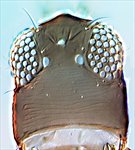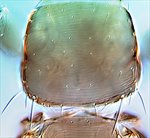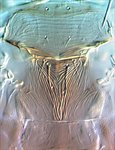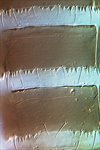
serrata head

serrata pronotum

serrata meso & metanota

serrata tergites VIII-IX

serrata sternites V-VII

serrata male sternites
Generic diagnosis
Female macropterous. Head slender; maxillary palps 3-segmented; eyes without pigmented facets; ocellar setae I absent; setae II longer than setae III; four or five pairs of postocular setae. Antennae 7-segmented; segment I without paired dorso-apical setae, III and IV with sense-cones forked, III–VI with some microtrichia on both surfaces. Pronotum with two pairs of long posteroangular setae; three pairs of posteromarginal setae. Mesonotum with median pair of setae far from posterior margin. Metanotum with longitudinal striae; median pair of setae behind anterior margin. Fore wing first vein with long gap in setal row, seven or eight basal and three distal setae; second vein with many setae equally spaced; clavus with five veinal and one discal setae; posteromarginal fringe cilia wavy. Prosternal ferna entire; basantra membranous, without setae; prospinasternum broad and transverse. Mesosternum with sternopleural sutures complete; endofurca without spinula. Metasternal endofurca without spinula. Tarsi 2-segmented. Tergites I–VIII with craspeda of long pointed teeth but these usually weaker medially; tergites V–VIII with paired ctenidia, on VIII posteromesad of the spiracles; IX with MD setae well developed, two pairs campaniform sensilla present; X with median split complete. Sternites without discal setae; II–VII with craspeda of long pointed teeth, but not medially on VII; III–VII with three pairs of posteromarginal setae, II with two pairs; sternite VII with S1 setae in front of posterior margin; laterotergites without discal setae, with craspeda similar to those on tergites.
Male similar to female; sternites III–VII each with a pore plate.
Biological data
Breeding on the leaves of sugar cane (Saccharum), to which it is possibly host-specific.
Distribution data
Originally from southeast Asia where it is widespread, this thrips is introduced to the Caribbean (Mound & Marullo, 1996) and also to South Africa.
Nomenclatural data
Fulmekiola Karny, 1925: 18. Type species Fulmekiola interrupta Karny, 1925, by original designation; synonym of Thrips serrata Kobus.
Only one species is placed in this genus (ThripsWiki, 2020), and this is recorded widely in China:
serrata (Kobus, 1893: 16). (Thrips)
Relationship data
Thripidae sub-family Thripinae: this is a diverse group involving more than 230 genera. Within this group, Fulmekiola is a member of the Thrips genus-group (Mound, 2002), and the only species included is particularly closely related to the Poaceae-specific thrips in the genus Stenchaetothrips. However, the tergites and sternites have distinctive posteromarginal craspeda with long pointed teeth.
References
Mound LA & Marullo R (1996) The Thrips of Central and South America: An Introduction. Memoirs on Entomology, International 6: 1–488.
Mound LA (2002) The Thrips and Frankliniella genus groups: the phylogenetic significance of ctenidia. Pp. 379–386 in Marullo R & Mound LA [eds] Thrips and Tospoviruses: Proceedings of the 7th International Symposium on Thysanoptera. Australian National Insect Collection, Canberra.
ThripsWiki (2020) ThripsWiki - providing information on the World's thrips. <http://thrips.info/wiki/Main_Page>